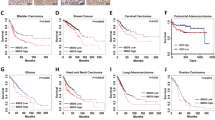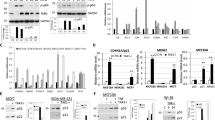Abstract
There is an increasing interest in determining the role of ribosomal proteins (RPs) in the regulation of MDM2–p53 pathway in coordinating cellular response to stress. Herein, we report a novel regulatory role of ribosomal protein S25 (RPS25) in MDM2-mediated p53 degradation and a feedback regulation of S25 by p53. We demonstrated that S25 interacted with MDM2 and inhibited its E3 ligase activity, resulting in the reduction of MDM2-mediated p53 ubiquitination and the stabilization and activation of p53. S25, MDM2 and p53 formed a ternary complex following ribosomal stress. The nucleolar localization and MDM2-binding domains of S25 were critical for its role in MDM2-mediated p53 regulation. Knockdown of S25 by siRNA attenuated the induction and activation of p53 following ribosomal stress. S25 stabilized and cooperated with MDMX to regulate MDM2 E3 ligase activity. Furthermore, S25 was identified to be a transcriptional target of p53; p53 directly bound to S25 promoter and suppressed S25 expression. Our results suggest that there is a S25–MDM2–p53 regulatory feedback loop, which may have an important role in cancer development and progression.
This is a preview of subscription content, access via your institution
Access options
Subscribe to this journal
Receive 50 print issues and online access
$259.00 per year
only $5.18 per issue
Buy this article
- Purchase on Springer Link
- Instant access to full article PDF
Prices may be subject to local taxes which are calculated during checkout








Similar content being viewed by others
References
Levine AJ, Oren M . The first 30 years of p53: growing ever more complex. Nat Rev Cancer 2009; 9: 749–758.
Haupt Y, Maya R, Kazaz A, Oren M . Mdm2 promotes the rapid degradation of p53. Nature 1997; 387: 296–299.
Oliner JD, Pietenpol JA, Thiagalingam S, Gyuris J, Kinzler KW, Vogelstein B . Oncoprotein MDM2 conceals the activation domain of tumour suppressor p53. Nature 1993; 362: 857–860.
Kubbutat MH, Jones SN, Vousden KH . Regulation of p53 stability by Mdm2. Nature 1997; 387: 299–303.
Wu X, Bayle JH, Olson D, Levine AJ . The p53-mdm-2 autoregulatory feedback loop. Genes Dev 1993; 7: 1126–1132.
Jones SN, Roe AE, Donehower LA, Bradley A . Rescue of embryonic lethality in Mdm2-deficient mice by absence of p53. Nature 1995; 378: 206–208.
Vogelstein B, Lane D, Levine AJ . Surfing the p53 network. Nature 2000; 408: 307–310.
Brooks CL, Gu W . p53 ubiquitination: Mdm2 and beyond. Mol Cell 2006; 21: 307–315.
Vousden KH, Lu X . Live or let die: the cell's response to p53. Nat Rev Cancer 2002; 2: 594–604.
Marine JC, Lozano G . Mdm2-mediated ubiquitylation: p53 and beyond. Cell Death Differ 2010; 17: 93–102.
Warner JR, McIntosh KB . How common are extraribosomal functions of ribosomal proteins? Mol Cell 2009; 34: 3–11.
Bhat KP, Itahana K, Jin A, Zhang Y . Essential role of ribosomal protein L11 in mediating growth inhibition-induced p53 activation. EMBO J 2004; 23: 2402–2412.
Chen D, Zhang Z, Li M, Wang W, Li Y, Rayburn ER et al. Ribosomal protein S7 as a novel modulator of p53-MDM2 interaction: binding to MDM2, stabilization of p53 protein, and activation of p53 function. Oncogene 2007; 26: 5029–5037.
Dai MS, Lu H . Inhibition of MDM2-mediated p53 ubiquitination and degradation by ribosomal protein L5. J Biol Chem 2004; 279: 44475–44482.
Dai MS, Zeng SX, Jin Y, Sun XX, David L, Lu H . Ribosomal protein L23 activates p53 by inhibiting MDM2 function in response to ribosomal perturbation but not to translation inhibition. Mol Cell Biol 2004; 24: 7654–7668.
Jin A, Itahana K, O’Keefe K, Zhang Y . Inhibition of HDM2 and activation of p53 by ribosomal protein L23. Mol Cell Biol 2004; 24: 7669–7680.
Dai MS, Shi D, Jin Y, Sun XX, Zhang Y, Grossman SR et al. Regulation of the MDM2-p53 pathway by ribosomal protein L11 involves a post-ubiquitination mechanism. J Biol Chem 2006; 281: 24304–24313.
Lohrum MA, Ludwig RL, Kubbutat MH, Hanlon M, Vousden KH . Regulation of HDM2 activity by the ribosomal protein L11. Cancer Cell 2003; 3: 577–587.
Zhang Y, Wolf GW, Bhat K, Jin A, Allio T, Burkhart WA et al. Ribosomal protein L11 negatively regulates oncoprotein MDM2 and mediates a p53-dependent ribosomal-stress checkpoint pathway. Mol Cell Biol 2003; 23: 8902–8912.
Sun XX, DeVine T, Challagundla KB, Dai MS . Interplay between ribosomal protein S27a and MDM2 protein in p53 activation in response to ribosomal stress. J Biol Chem 2011; 286: 22730–22741.
Xiong X, Zhao Y, He H, Sun Y . Ribosomal protein S27-like and S27 interplay with p53-MDM2 axis as a target, a substrate and a regulator. Oncogene 2011; 30: 1798–1811.
Zhu Y, Poyurovsky MV, Li Y, Biderman L, Stahl J, Jacq X et al. Ribosomal protein S7 is both a regulator and a substrate of MDM2. Mol Cell 2009; 35: 316–326.
Sun XX, Dai MS, Lu H . 5-fluorouracil activation of p53 involves an MDM2-ribosomal protein interaction. J Biol Chem 2007; 282: 8052–8059.
Sun XX, Dai MS, Lu H . Mycophenolic acid activation of p53 requires ribosomal proteins L5 and L11. J Biol Chem 2008; 283: 12387–12392.
Takagi M, Absalon MJ, McLure KG, Kastan MB . Regulation of p53 translation and induction after DNA damage by ribosomal protein L26 and nucleolin. Cell 2005; 123: 49–63.
Ofir-Rosenfeld Y, Boggs K, Michael D, Kastan MB, Oren M . Mdm2 regulates p53 mRNA translation through inhibitory interactions with ribosomal protein L26. Mol Cell 2008; 32: 180–189.
Lindstrom MS, Jin A, Deisenroth C, White Wolf G, Zhang Y . Cancer-associated mutations in the MDM2 zinc finger domain disrupt ribosomal protein interaction and attenuate MDM2-induced p53 degradation. Mol Cell Biol 2007; 27: 1056–1068.
Macias E, Jin A, Deisenroth C, Bhat K, Mao H, Lindstrom MS et al. An ARF-independent c-MYC-activated tumor suppression pathway mediated by ribosomal protein-Mdm2 Interaction. Cancer Cell 2010; 18: 231–243.
Zhang Y, Lu H . Signaling to p53: ribosomal proteins find their way. Cancer Cell 2009; 16: 369–377.
Zhang Z, Zhang R . Proteasome activator PA28 gamma regulates p53 by enhancing its MDM2-mediated degradation. EMBO J 2008; 27: 852–864.
Chen D, Zhang J, Li M, Rayburn ER, Wang H, Zhang R . RYBP stabilizes p53 by modulating MDM2. EMBO Rep 2009; 10: 166–172.
Nishiyama T, Yamamoto H, Uchiumi T, Nakashima N . Eukaryotic ribosomal protein RPS25 interacts with the conserved loop region in a dicistroviral intergenic internal ribosome entry site. Nucleic Acids Res 2007; 35: 1514–1521.
Landry DM, Hertz MI, Thompson SR . RPS25 is essential for translation initiation by the Dicistroviridae and hepatitis C viral IRESs. Genes Dev 2009; 23: 2753–2764.
Li M, Center MS . Regulation of ribosomal protein S25 in HL60 cells isolated for resistance to adriamycin. FEBS Lett 1992; 298: 142–144.
Adilakshmi T, Laine RO . Ribosomal protein S25 mRNA partners with MTF-1 and La to provide a p53-mediated mechanism for survival or death. J Biol Chem 2002; 277: 4147–4151.
Castro ME, Leal JF, Lleonart ME, Ramon YCS, Carnero A . Loss-of-function genetic screening identifies a cluster of ribosomal proteins regulating p53 function. Carcinogenesis 2008; 29: 1343–1350.
Parant J, Chavez-Reyes A, Little NA, Yan W, Reinke V, Jochemsen AG et al. Rescue of embryonic lethality in Mdm4-null mice by loss of Trp53 suggests a nonoverlapping pathway with MDM2 to regulate p53. Nat Genet 2001; 29: 92–95.
Pan Y, Chen J . MDM2 promotes ubiquitination and degradation of MDMX. Mol Cell Biol 2003; 23: 5113–5121.
Meulmeester E, Frenk R, Stad R, de Graaf P, Marine JC, Vousden KH et al. Critical role for a central part of Mdm2 in the ubiquitylation of p53. Mol Cell Biol 2003; 23: 4929–4938.
Argentini M, Barboule N, Wasylyk B . The contribution of the acidic domain of MDM2 to p53 and MDM2 stability. Oncogene 2001; 20: 1267–1275.
Horn HF, Vousden KH . Cooperation between the ribosomal proteins L5 and L11 in the p53 pathway. Oncogene 2008; 27: 5774–5784.
Laine RO, Shay NF, Kilberg MS . Nuclear retention of the induced mRNA following amino acid-dependent transcriptional regulation of mammalian ribosomal proteins L17 and S25. J Biol Chem 1994; 269: 9693–9697.
Golomb L, Bublik DR, Wilder S, Nevo R, Kiss V, Grabusic K et al. Importin 7 and exportin 1 link c-Myc and p53 to regulation of ribosomal biogenesis. Mol Cell 2012; 45: 222–232.
Budde A, Grummt I . p53 represses ribosomal gene transcription. Oncogene 1999; 18: 1119–1124.
Mancini F, Di Conza G, Monti O, Macchiarulo A, Pellicciari R, Pontecorvi A et al. Puzzling over MDM4-p53 network. Int J Biochem Cell Biol 2010; 42: 1080–1083.
Linares LK, Hengstermann A, Ciechanover A, Muller S, Scheffner M . HdmX stimulates Hdm2-mediated ubiquitination and degradation of p53. Proc Natl Acad Sci USA 2003; 100: 12009–12014.
Marine JC, Dyer MA, Jochemsen AG . MDMX: from bench to bedside. J Cell Sci 2007; 120 (Part 3): 371–378.
Jackson MW, Berberich SJ . MdmX protects p53 from Mdm2-mediated degradation. Mol Cell Biol 2000; 20: 1001–1007.
Stad R, Little NA, Xirodimas DP, Frenk R, van der Eb AJ, Lane DP et al. Mdmx stabilizes p53 and Mdm2 via two distinct mechanisms. EMBO Rep 2001; 2: 1029–1034.
Mancini F, Di Conza G, Pellegrino M, Rinaldo C, Prodosmo A, Giglio S et al. MDM4 (MDMX) localizes at the mitochondria and facilitates the p53-mediated intrinsic-apoptotic pathway. EMBO J 2009; 28: 1926–1939.
Gilkes DM, Chen L, Chen J . MDMX regulation of p53 response to ribosomal stress. EMBO J 2006; 25: 5614–5625.
Ruggero D, Pandolfi PP. . Does the ribosome translate cancer? Nat Rev Cancer 2003; 3: 179–192.
Narla A, Ebert BL . Ribosomopathies: human disorders of ribosome dysfunction. Blood 2010; 115: 3196–3205.
Loging WT, Reisman D . Elevated expression of ribosomal protein genes L37, RPP-1, and S2 in the presence of mutant p53. Cancer Epidemiol Biomarkers Prev 1999; 8: 1011–1016.
Artero-Castro A, Castellvi J, Garcia A, Hernandez J, Ramon y Cajal S, Lleonart ME . Expression of the ribosomal proteins Rplp0, Rplp1, and Rplp2 in gynecologic tumors. Hum Pathol 2011; 42: 194–203.
Acknowledgements
We thank Dr J Chen for the kind gift of the MDMX plasmid; Dr G Lozano for the mdmx−/−p53−/− and mdm2−/−p53−/− MEF cell lines; and Drs G Jin, D Chen, Z Zhang, L Ao, X Yang, J Qin and S Voruganti for helpful discussions and excellent technical support. This work was supported in part by NIH/NCI grants R01 CA112029, R01 CA121211 and a Susan G Komen Foundation grant BCTR0707731 (to RZ). MW was supported by NIH grant R01 CA91980. HW was supported by the One Hundred Talents Program, Chinese Academy of Sciences, grants from National Nature Science Foundation (30870513, 31070680, 91029715 and 81025017) and Ministry of Science and Technology of China (2007CB947100), the Science and Technology Commission of Shanghai Municipality (08391910800, 10391902100), National Science and Technology Major Project ‘Key New Drug Creation and Manufacturing Program’ (2009ZX09102-114, 2009ZX09301-011).
Author information
Authors and Affiliations
Corresponding author
Ethics declarations
Competing interests
The authors declare no conflict of interest.
Additional information
Supplementary Information accompanies the paper on the Oncogene website
Rights and permissions
About this article
Cite this article
Zhang, X., Wang, W., Wang, H. et al. Identification of ribosomal protein S25 (RPS25)–MDM2–p53 regulatory feedback loop. Oncogene 32, 2782–2791 (2013). https://doi.org/10.1038/onc.2012.289
Received:
Revised:
Accepted:
Published:
Issue Date:
DOI: https://doi.org/10.1038/onc.2012.289
Keywords
This article is cited by
-
Loss of RPS27a expression regulates the cell cycle, apoptosis, and proliferation via the RPL11-MDM2-p53 pathway in lung adenocarcinoma cells
Journal of Experimental & Clinical Cancer Research (2022)
-
Effects of water-soluble components of atmospheric particulates from rare earth mining areas in China on lung cancer cell cycle
Particle and Fibre Toxicology (2021)
-
Ribosomal L1 domain-containing protein 1 coordinates with HDM2 to negatively regulate p53 in human colorectal Cancer cells
Journal of Experimental & Clinical Cancer Research (2021)
-
The roles of ribosomal proteins in nasopharyngeal cancer: culprits, sentinels or both
Biomarker Research (2021)
-
In silico evidence of de novo interactions between ribosomal and Epstein - Barr virus proteins
BMC Molecular and Cell Biology (2019)



